Fairy Tales & Fables Part 1: Little Red Riding Hood, The Three Billy Goats Gruff, & The Three Little Pigs
There are so many reasons for parents to read fairy tales and fables to young
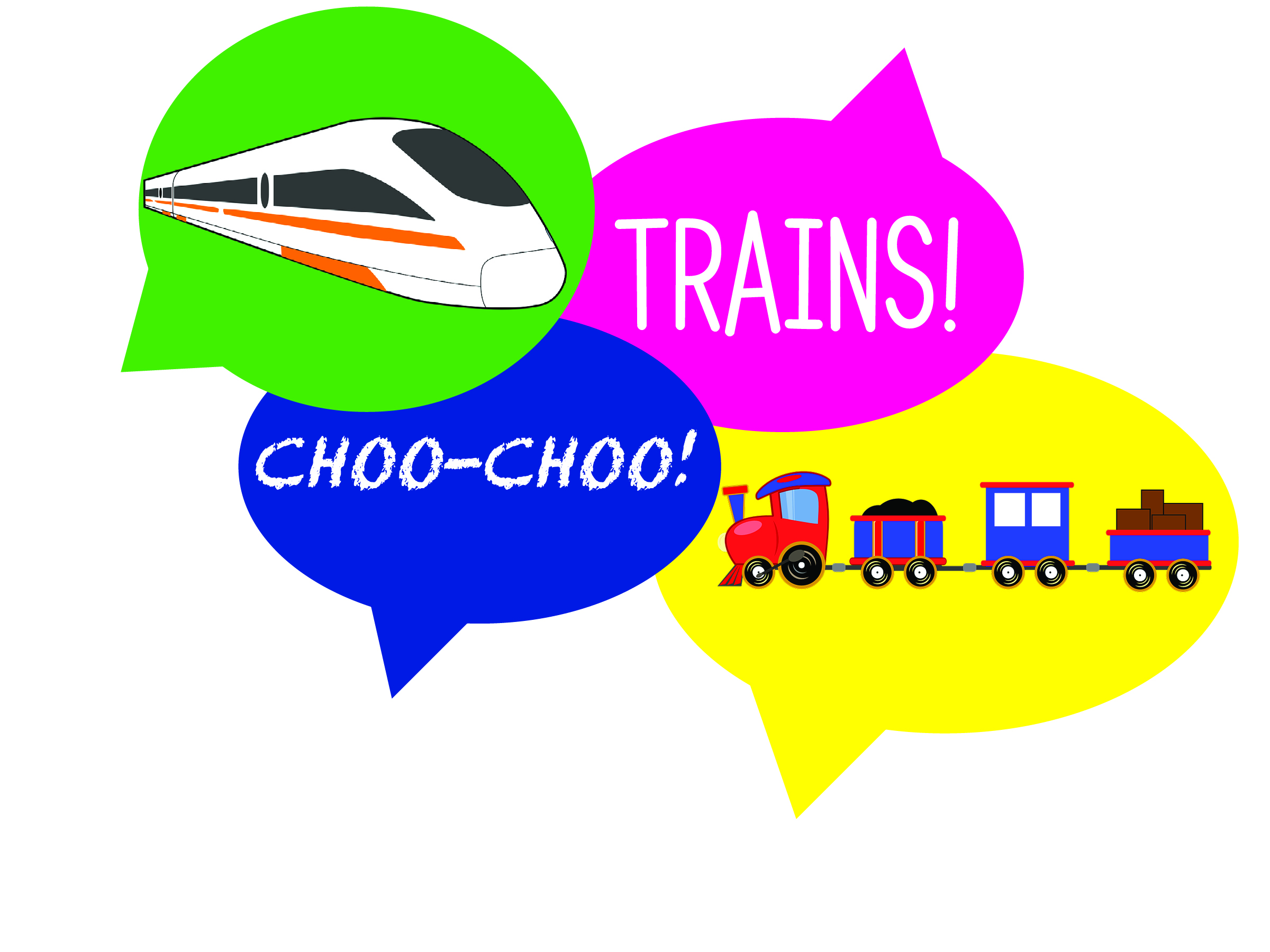
Restricted interests. Special interests. Passions. Obsessions. Whatever you call them, it can be challenging when a child with autism is fixated on something all day, every day, to the exclusion of anything (or anyone) else.
I knew the stereotypes about autistic people when my twins were diagnosed at 2. So I felt panicky when my son Luke began to obsess over trains and cars or pretend to be a firetruck for hours. For my other son Harry, it was perseverating with the alphabet, and later, about animals. "Oh yeah," friends would say, "my kid really likes trains too," and my whole body would stiffen. No. You don't get it, I'd think. This is different.
One of the boys' therapists, BCBA Mindy Smith, was special for many reasons, but an important quality of her approach was that she saw my sons' obsessions as opportunities. When I asked her about this recently, she said, "As a behavior therapist, I find it extremely exciting when a child is highly motivated by something specific because I know I can use that to build on their repertoire of interests and knowledge. So with a child like Luke, who is really interested in trains, I can use that to introduce him to new kinds of play and activities he might not otherwise try. You can count trains, you can label them, describe them with adjectives, and so on. You can build train puzzles, read train books, color a train picture, and do an obstacle course where you earn parts of a train. Obviously, every kid with autism is different and sometimes these fixations need to be managed if they get in the way of functional behavior. It's best to consult a BCBA if you are concerned."
My new regular column Obsessed will provide readers with curated book lists for some of the more common restricted interests of children with autism. I'm kicking it off with my son Luke's primary obsession: Trains.
Kathleen O'Brien, a parent-friend of mine, published a gem of an op-ed in the New York Times earlier this week: ("For ‘Train Kids,’ the Second Avenue Subway Is a Dream Come True"). She paints a vivid picture of New York City children with autism and their near-universal love for the subway system:
A spanking-new city subway line is also a big deal for “train kids” like mine. New York is a place where kids memorize the subway maps and see the world through a subway lens. And for many children affected by autism, like my son, the trains take on a mythic status, becoming a joy and a fixation. Trains may appeal to people on the autism spectrum because of the rapid visual stimulation they offer and the reliability and predictability of their routes and schedule; the toy versions also have spinning wheels that children with autism often love.
Of course it's not just New York City kids who love trains, and happily, there are lots of books that cater to kids with this interest. Here are 9 really good ones:
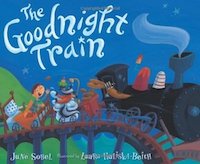
HMH Books for Young Readers, 2012; board book, $7.99 USD

I previously reviewed this book in my post about bedtime stories. I love it because it has rhyming verse, perfect meter, and really nails the feeling of a train in motion speeding up and slowing down again. The illustrations of the train's journey even have a slight social story element, showing pictures of toothbrushes and pillows and other bedtime things.
The large variety of high-interest train sound effects (part of the poem) are helpfully spelled out for sound effect novices.
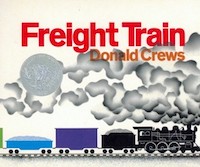
Greenwillow Books (1978); hardcover, $16.99 USD

This Caldecott honor book is a classic. Our copy is my wife's childhood edition, signed by the author in 1985. The illustrations are sparse and uncluttered, which works much better for my son Luke. He is highly interested in all those YouTube videos with different kinds of trains (number trains, color trains, shape trains, etc.) and this book is basically the original color train, so it has his attention.
You approach the train from behind, catching up to the red caboose, and then moving up through six different colored cars ("Green cattle car," etc.) until you reach "Black steam engine." You then pan out to see the whole colorful train. A few words on each page describe its journey (ie. "Going through tunnels" or "Moving in darkness.") At the end, you are left with a puff of smoke and empty track.
The visuals are enchanting and the pops of color are highly motivating for kids who enjoy labeling colors.
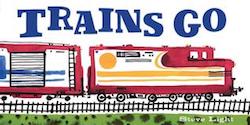
Chronicle Books (2012); large format board book, $9.99 USD

Steve Light has a whole series of books about different kinds of vehicles, but Trains Go is my favorite.
This beautiful book introduces you to 8 kinds of trains and their special sounds. The sounds are given with an artistic dash of onomatopoeia; Steve Light uses color, font choice, letter size, spelling, and other typograhical effects to create words on the page that somehow look like their sounds. I think those visual elements enhanced the interactive potential of the book for Luke, who read this book with me a lot when he was 2, back when it was a struggle to get him to talk at all. Trains Go is also perfect for a child who has trouble attending to longer books.
This is also the kind of book that lends itself well to a solo read. The pictures are attractive, imply motion wonderfully, and the book itself is interesting because of its unusual shape. Especially for kids who struggle with stimming, something functional in their repertoire (like flipping through an appealing book alone), can be extremely useful. Trains Go is, in this respect, a better choice than any number of first board books with pictures of trains because it can be used for social reading later. It's harder to read labels alone ("freight train," "steam engine," etc.), without it being dull and awkward. But reading "The big steam train goes CHUGGA CHUGGA CHUGGA CHUGGA CHUGGA CHUGGA CHOO CHOOOOOOOOO!" works.
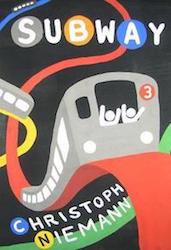
HarperCollins Children's Books (2010); hardcover, $16.99

It's raining, so a father and two kids go on a New York City subway adventure. The opening pages thrill with the wind and rumble of an approaching train in the tunnel as seen from a platform edge. Then the family boards their first train (the A) and readers are treated to a romp through the city's iconic underground.
The use of the official MTA letter and number symbols for all the train lines, and the vibrant, high-contrast illustrations are bee-to-honey-level fabulousness. Niemann did a wonderful job in his drawings of suggesting action and the sensory feel of the subway--right down to the scurrying of rats on the tracks at a J-train stop.
The text rhymes passably, but the rhythm is sometimes awkward. For a subway-loving kid, none of these quibbles matter because you are likely to have a lot of starts and stops as your child takes time exploring each page. A must-have for New Yorkers.
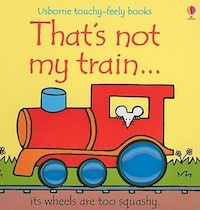
Usborne (2008); board book, $9.99 USD

I've gushed about Usborne Touchy Feely books before. They are great for sensory seeking children and help to generalize an interest in books. They also provide children with ways to get their sensory fix without stimming.
"That's Not My Train" has both tactile and visual sensory elements. The text is concise: "That's not my train. It's wheels are too squashy," says an adorable mouse character on the first page. Each subsequent page repeats this format with a new train and and sensory element, exploring the parts of a train as you go. The repetition is helpful, providing the kind of structure some children need to connect to a book.
It sounds obvious, but I can't tell you how long it took me to recognize that Luke was obsessed with trains but didn't know how to label the parts of one. It was great to watch him pick up not just "windows" but "shiny windows;" the sensory elements of the book made it exciting enough to help him expand his utterances.
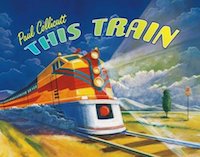
Farrar Straus Giroux Books for Young Readers (1999); board book, $7.99 USD

The structure of this book is simple: facing pages contrast two trains by some attribute. The first spread's two pages say, "This train is yellow. / This train is red."
This line ("This train is...") repeats, and the book's spreads show many simple attributes like old/new, but also more complex ones like on a bridge/in a tunnel or carries passengers/carries freight. The art is pretty and colorful, a call back to classic vintage posters.
Sometimes the illustrations aren't as good at showing what's in the text as they should be. The yellow/red spread, for instance, is confusing because while one train is more yellow and the other more red, they are both actually yellow and red. But overall this book is a great way to introduce or generalize opposites, and the huge variety of colorful trains and settings creates a lot of interest.
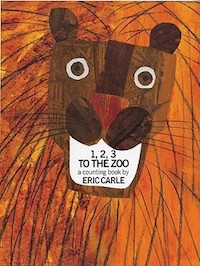
Philomel Books (1982); hardcover, $16.99 USD

I wrote a special post on some of my sons' favorite Eric Carle books last spring, but we hadn't discovered this one yet.
1, 2, 3 to the Zoo is in the animal train genre. Basically, the book shows the different cars of a train headed to the zoo that contain an (increasing) number of animals (to 10). The animals are standard zoo fare (1 elephant, 2 hippos, 3 giraffes, etc.). The number of animals does appear in the corner of each page, but other than that there is no text.
When the train reaches the zoo, the animals are seen in their enclosures in a pull-out illustrated map of the zoo (my least favorite book element, I'm convinced it's going to get torn some day soon).
This is a good pick for a train-loving kid who needs to practice rote counting to 10 and labeling zoo animals. It's also got potential for use practicing sequencing since there is a mini-train along the bottom of each page that adds the animal cars one by one as the book progresses.
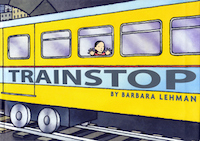
HMH Books for Young Readers (2008); hardcover, $16.99 USD

This is a wordless picture book, which as I've mentioned before, can be really great for kids with scripting problems since the reader will tend to use different words each time they read the book. They are also great for practicing the difficult skill of construction of narrative: first this happens, then this, then this thing.
This book depicts one of my favorite tropes of children's literature: crossing the threshold from the mundane world to a fantastical one. The little girl boards a train, and we watch her excited face looking out the train window as it crosses over from a dull cityscape into a green, lush land populated by tiny toy-people. When she returns after a short adventure, she brings the color with her, brightening the gray tones of the city.
Too many of the really popular wordless picture books are artful in ways that are challenging for children with autism. This book has clear, understandable images, and includes lots of elements and actions that many children are likely to know as emerging language learners. While this book requires skills my son Luke doesn't have yet, for my son Harry, who speaks more easily, this is a perfect challenge.
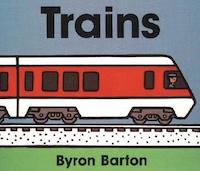
HarperFestival (1986); board book, $6.99 USD

This little board book is an old classic that many 80s children will remember instantly from their own childhoods. The illustrations are high-contrast and favor primary colors, and so grab attention easily. The cartoon-like nature of the book makes Trains perfect book for playing I Spy, because without being too cluttered there are lots of setting elements that pop out.
What's great about this book's text is its use of full, descriptive sentences that still keep the economy of words to a minimum. It's easy to point to the pictures and deliver the clear, declarative text like "Here are the freight cars. The caboose is last."
But what makes this book special for all its simplicity is how unusual it is for a book like this to be so filled with people--passengers riding trains, workers fixing the track, an engineer driving the train, passengers waiting at the station, and a conductor helping them board. For a child with autism who fixates on trains, and may not be as socially inclined, it's good to see how trains connect to people.